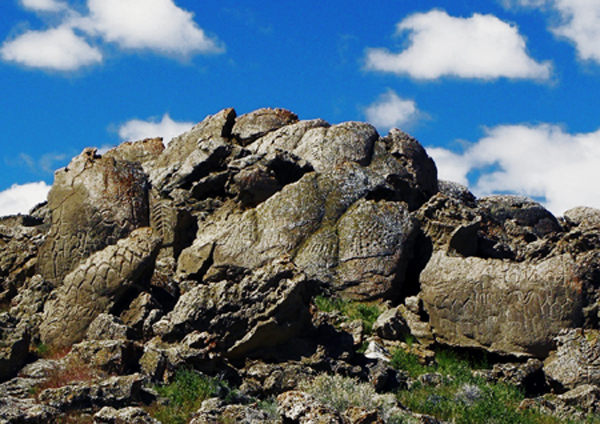


The petroglyphs of Winnemucca Lake, a dry lake bed lying in northwest Nevada, have now been dated, and the carvings are claimed to be the oldest yet known in North America, almost 15,000 years old.

Photo: University of Colorado
The petroglyphs consist of symbols, carved in soft limestone probably by harder volcanic rock fragments, ranging in size from 20 cms to 100 cms in width. A team of scientists led by Larry Benson, of the University of Colorado Natural History Museum in Boulder, claim that they are between 10,500 and 14,800 years old.
The dating method involved radiocarbon testing on the mineral carbonate layers formed when the decorated rocks were submerged. The rocks were exposed - for carving - between about 14,800 to 13,100 years ago, and again from about 11,300 to 10,500 years ago. This, however, does not indicate the time span for the carvings; over a short period of time, or more extended.
Discoveries at the Paisley Cave in Oregon of several pieces of fossilized human feces, or coprolites, dated approximately between 14,400 to 13,000 years ago, currently suggest the earliest dates for human colonization of the Americas, as supported by the genetic evidence. This early wave of colonizers may have been responsible for this rock art.
by Bradshaw Foundation
Wednesday 23 July 2025
by Bradshaw Foundation
Thursday 29 May 2025
by Bradshaw Foundation
Monday 03 February 2025
by Bradshaw Foundation
Friday 09 August 2024
by Bradshaw Foundation
Wednesday 24 July 2024
by Bradshaw Foundation
Thursday 04 July 2024
by Bradshaw Foundation
Monday 01 July 2024
by Bradshaw Foundation
Wednesday 20 March 2024
by Bradshaw Foundation
Tuesday 13 February 2024
by Bradshaw Foundation
Tuesday 13 February 2024
by Bradshaw Foundation
Thursday 01 February 2024
by Bradshaw Foundation
Tuesday 28 November 2023
by Bradshaw Foundation
Thursday 23 November 2023
by Bradshaw Foundation
Monday 20 November 2023
by Bradshaw Foundation
Tuesday 31 October 2023
by Bradshaw Foundation
Thursday 26 October 2023
by Bradshaw Foundation
Wednesday 23 July 2025
by Bradshaw Foundation
Thursday 29 May 2025
by Bradshaw Foundation
Monday 03 February 2025
by Bradshaw Foundation
Friday 09 August 2024
by Bradshaw Foundation
Wednesday 24 July 2024
by Bradshaw Foundation
Thursday 04 July 2024
by Bradshaw Foundation
Monday 01 July 2024
by Bradshaw Foundation
Wednesday 20 March 2024
by Bradshaw Foundation
Tuesday 13 February 2024
by Bradshaw Foundation
Tuesday 13 February 2024
by Bradshaw Foundation
Thursday 01 February 2024
by Bradshaw Foundation
Tuesday 28 November 2023
by Bradshaw Foundation
Thursday 23 November 2023
by Bradshaw Foundation
Monday 20 November 2023
by Bradshaw Foundation
Tuesday 31 October 2023
by Bradshaw Foundation
Thursday 26 October 2023
Friend of the Foundation











